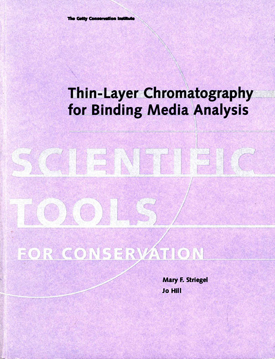
Thin-Layer Chromatography for Binding Media Analysis
Mary F. Striegel and Jo Hill
1996
184 pages
PDF file size: 4 MB
Description
In the study and conservation of art and artifacts, natural organic materials are frequently encountered in components such as coatings, binders, and adhesives. The identification of these materials is often crucial to the attempt to characterize the technologies employed by artists or craftspeople, understand the processes and causes of deterioration, and plan appropriate conservation treatments. Yet the limited resources of many conservation laboratories put many analysis techniques beyond their reach. Thin-layer chromatography can help fill this gap.
The volume consists of a handbook, protocols, and guide to reference materials. The handbook serves as a primer for the basic application of thin-layer chromatography to the analysis of binding media, adhesives, and coatings found on cultural objects; the protocols provide step-by-step instructions for the laboratory procedures involved in typical analyses; and the guide to reference materials aids in the understanding of the types of materials and documentation needed for accurate analyses by thin-layer chromatography.
Table of Contents
- Foreword
- Preface
- Introduction
- Part One: Handbook
- Chapter 1: An Overview of Thin-layer Chromatography
- Comparison of TLC to Other Chromatographic Methods
- The History of TLC
- The Early Years: 1938-1951
- The Classical Period: 1956-1980
- The Modern Period: 1981-Present
- Theoretical Aspects of Thin-Layer Chromatography
- Chapter 2: Technique of Thin-Layer Chromatography
- Sample Preparation
- Selection of the Chromatographic Plate
- Selection of a Solvent System
- Spotting the Sample
- Development of the TLC Plate
- Detection of Separation Zones
- Visual Examination
- Documentation
- Chapter 3: Methodology for Thin-Layer Chromatography
- Sorbent layers
- Solvent Systems
- Development Chambers
- Detection Methods
- Documentation
- Chapter 4: Analysis of Proteins by Thin-Layer Chromatography
- A Summary of the Use and Chemistry of Proteinaceous Binders
- Analytical Methodology
- Sample Preparation
- Technique
- Applications
- Chapter 5: Analysis of Carbohydrates by Thin-Layer Chromatography
- A Summary of the Use and Chemistry of Carbohydrate Binders
- Analytical Methodology
- Sample Preparation
- Technique
- Applications
- Chapter 6: Analysis of Waxes by Thin-Layer Chromatography
- A Summary of the Use and Chemistry of Wax Binders
- Analytical Methodology
- Sample Preparation
- Technique
- Applications
- Chapter 7: Analysis of Resins by Thin-Layer Chromatography
- A Summary of the Use and Chemistry of Resin Coatings
- Analytical Methodology
- Sample Preparation
- Technique
- Applications
- Chapter 8: Visualization, Interpretation, Documentation, and Computer Analysis
of Chromatographic Plates
- Visualization Reagents
- Physical Methods
- Chemical Methods
- Interpretation of the TLC Plate
- Qualitative Methods
- Quantitative Methods
- Documentation
- Manual-Graphical Methods
- Photographic Methods
- Written Record of Conditions
- Computer Methods for Evaluation of the TLC Plate
- Visualization Reagents
- Chapter 9: Scientific Examination of Works of Art
- A Review of the Uses of TLC in the Examination of Works of Art
- Protein Analysis
- Carbohydrate Analysis
- Wax Analysis
- Resin Analysis
- Some Potential Systems for Media Analysis by TLC
- A Review of the Uses of TLC in the Examination of Works of Art
- Chapter 1: An Overview of Thin-layer Chromatography
- Part Two: Protocols
- Introduction
- Protocol A: Identification of Proteins by Thin-Layer Chromatography
- Protocol B: Identification of Carbohydrates by Thin-Layer Chromatography
- Protocol C: Identification of Waxes by Thin-Layer Chromatography
- Protocol D: Identification of Resins by Thin-Layer Chromatography
- Protocol E: Written Documentation of the TLC Plate
- Protocol F: Photodocumentation of the TLC Plate Using Visible Light
- Protocol G: Photodocumentation of the TLC Plate Using Ultraviolet Light
- Protocol H: Sample Application for Thin-Layer Chromatography
- Protocol I: Evaluation of a TLC Plate
- Protocol J: Acid Hydrolysis in a Pierce Vial Reaction Chamber
- Protocol K: Vapor Phase Acid Hydrolysis in a Pierce Vial Reaction Chamber
- Protocol L: Semiquantitative Computer Analysis of a TLC Plate
- Glossary
- About the Authors
About the Authors
Mary F. Striegel was an assistant scientist at the Getty Conservation Institute for six years before joining the staff of the National Center for Preservation Technology and Training as a materials scientist in 1995. Her research includes the application of new analytical methods to the examination of artist materials. Her interests include technical photography and acoustic microscopy.
Jo Hill has specialties in objects conservation, textile conservation, and scientific analysis and research. She currently serves as director of conservation for the Fowler Museum of Cultural History. Her special interests include the materials and techniques of artifact fabrication, the conservation of painted surfaces, teaching, and the application of scientific research to the field of art conservation.